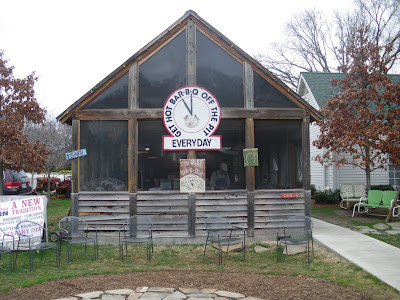 This was one of the most interesting, unique museums I've ever been to, and one of the coolest things we did on our trip. As a Martin Luther King admirer, I was initially worried that it might be too sad and depressing to see the place where he was shot. But I'm glad we went there. It was poignant, but somehow visiting it felt more inspiring and positive than sad. The pokey, shabby, totally ordinary quality of the motel really brought home the truth that, yes, Martin Luther King was a real person, and despite all the great things he accomplished, he was still just a man staying at a crummy hotel, just like any other regular person. In a weird way, this realization makes his achievements even more impressive. He wasn't a superhero, he wasn't magical...he was a human being who was called to greatness and who was brave enough to answer the call.
This was one of the most interesting, unique museums I've ever been to, and one of the coolest things we did on our trip. As a Martin Luther King admirer, I was initially worried that it might be too sad and depressing to see the place where he was shot. But I'm glad we went there. It was poignant, but somehow visiting it felt more inspiring and positive than sad. The pokey, shabby, totally ordinary quality of the motel really brought home the truth that, yes, Martin Luther King was a real person, and despite all the great things he accomplished, he was still just a man staying at a crummy hotel, just like any other regular person. In a weird way, this realization makes his achievements even more impressive. He wasn't a superhero, he wasn't magical...he was a human being who was called to greatness and who was brave enough to answer the call.Originally named the Windsor Hotel c. 1925.
Renamed Marquette Hotel in 1945 and offered for sale.
Purchased by Walter Bailey in 1945 and renamed the Lorraine, after his wife Loree and a song titled “Sweet Lorraine.” At the time of purchase the Lorraine included 16 rooms, a café, and living quarters for the Baileys.
The Lorraine became one of only a few hotels to which African American travelers could enjoy overnight accommodations while traveling during this segregated period leading up to the late 1960s in America.
Under the Bailey’s ownership there were at least two major additions to the hotel. The first addition added a second floor and 12 rooms to the hotel while the next addition created even more guest rooms and drive up access. This change converted the Lorraine Hotel into a motel.
Guests of the Lorraine, both black and white, returned time and again for its upscale atmosphere, home cooked meals, including bar-b-que, affordable prices, and its reputation as a clean and safe environment.
Song writers and musicians working with the Stax Records Company were frequent residents of the Lorraine. Recording stars Ray Charles, Lionel Hampton, Aretha Franklin, Ethel Waters, Otis Redding, The Staple Singers and Wilson Picket were among the many that stayed in the Lorraine during the heyday of the late 1950s- early 1960s.
Dr. Martin Luther King, Jr. stayed at the Lorraine Motel numerous times. He was a guest of the Lorraine when he came to Memphis in 1968 in support of striking sanitation workers.
The Lorraine Motel is designated an historic site by the Tennessee Historical Commission.
History of the National Civil Rights Museum
The National Civil Rights Museum was birthed out of the success of the civil rights movement and the tragic violence that occurred at the Lorraine Motel, taking the life of Dr. Martin Luther King, Jr.
The aftershock of the assassination on April 4, 1968 eventually plunged the Lorraine into a long and steep decline. The motel’s owner, Walter Lane Bailey maintained two rooms – Rooms 306 & 307 - as a shrine to Dr. King and in memory of his wife Loree who died days after the assassination.
Realizing the symbolic significance of the Lorraine, Mr. Bailey reached out for help to maintain the property as a civil rights shrine. He reached out to Mr. Chuck Scruggs, program director of local radio station WDIA radio and the Save The Lorraine campaign was born.
A group of prominent Memphians, concerned that this historical site would be destroyed through continued neglect and indifference, formed the Martin Luther King Memorial Foundation and in 1984 changed its name to the Lorraine Civil Rights Museum Foundation.
Under the leadership of local attorney and activist, D’Army Bailey, the Foundation raised enough money to purchase the property on the courthouse steps at a public auction for $144,000.
Using a design report by former Smithsonian Institution curator, Benjamin Lawless, the Foundation moved forward to create the educational facility and memorial site that today is the National Civil Rights Museum.
The Museum was dedicated on July 4, 1991 and officially opened to the public on Sept. 28, 1991. Since opening the museum records more than 5 million to the site.
In 1999 the Museum acquired properties facing it, the former Canipe’s Amusement store and rooming house, which were an integral part of Dr. King’s assassination investigation. In 1968, James Earl Ray stayed in the rooming house.
The museum became custodian of the police and evidence files associated with the manhunt, indictment and confession of the assassin of Dr. King. This transfer affords the National Civil Right Museum the distinction of being the first museum of its kind to receive evidence materials and court documents connected with a criminal case into its collection holdings.
Opened to the public on Sept. 28, 2002, Exploring the Legacy, is a 12,800 sq. ft. expansion project aimed at addressing three key questions: 1) Did the Movement die with Dr. King? 2) Was James Earl Ray the assassin? and, 3) What is the legacy of the movement?

































